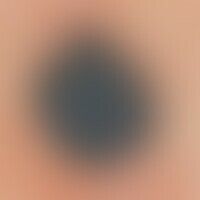Image diagnoses for "Scalp (hairy)"
120 results with 343 images
Results forScalp (hairy)

Folliculitis decalvans L66.2
Folliculitis decalvans. 4 years of persistent, chronically active, progressive, red, follicle-related, rough, partly scaly, partly solitary, partly confluent papules on the capillitium of a 46-year-old man. In between, skin-coloured or white, hard, smooth, scarred plaques appear on which the follicles are completely missing.

Folliculitis decalvans L66.2
Folliculitis decalvans: Alopecia like a footstep with fresh and older scars. Left picture: Inflammatory area with yellowish crusts. The process has been going on for several years, in attacks which last several months. Oral antibiotics improve the severity of the attacks.

Folliculitis decalvans L66.2
Folliculitis decalvans, circumscribed scarring alopecia with extensive reddening of the skin.

Folliculitis decalvans L66.2
Folliculitis decalvans, massive extensive scarring, currently no inflammatory activity of the process.

Folliculitis decalvans L66.2
Folliculitis decalvans: Initial changes, scalp appears swollen, with sunken, conspicuously prominent follicular structures, occasional tufts, individual follicles without hairline.

Folliculitis decalvans L66.2
Folliculitis decalvans, scarredfinal state with tufts of hair running diagonally through the scalp.

Infant haemangioma (overview) D18.01

Impetigo contagiosa, small vesicles L01.0
Impetigo contagiosa, small vesicles: Pronounced impetigo in a 14-year-old Ethiopian girl, no pretreatment so far.

Squamous cell carcinoma of the skin C44.-
Squamous cell carcinoma of the skin: approx. 3 cm in diameter, coarse, crusty, exuding tumour with an inflammatory reddening of the edges in the area of the neck of a 95-year-old female patient, which empties purulent secretion under pressure.

Squamous cell carcinoma of the skin C44.-
Squamous cell carcinoma of the skin: 1.5 cm large, spherical, red node (tumor) with ulcerated surface and hemorrhagic crust on the forehead of a 67-year-old female patient.

Squamous cell carcinoma of the skin C44.-
Squamous cell carcinoma in actinically damaged skin; for more than 1 year, slowly growing, bowl-shaped, very firm, little pain-sensitive, ulcerated lump, which (at the time of examination) was no longer movable on its base.

Squamous cell carcinoma of the skin C44.-
Squamous cell carcinoma of the skin: large-area desmoplastic carcinoma of the scalp, which extended far beyond the clinically suspected infiltrate zone.

Keratoakanthoma (overview) D23.-
Keratoakanthoma classic type: In actinic severely damaged scalp opened, fast growing (since about 6 weeks existing) painless lump with peripherally raised wall and a central horn plug.

Keratoacanthomas multiple eruptive D23.L
Keratoakanthomas, multiple eruptive. suddenly formed, now 1.0 cm in diameter, hard, painless, bowl-shaped node with marginal lip and central horn plug (typical morphology). sliding on the pad. no regional lymph node swelling. in the surrounding area beside single actinic keratoses, several skin-coloured or slightly yellowish solid papules up to 0.4 cm in size (initial keratoakanthomas). 73-year-old patient with long-term immunosuppression (!).

Actinic keratosis L57.0
Keratosis actinica keratotic type:numerous, hyperkeratotic, in places also lichenoid, red papules and plaques on the capillitium of an 85-year-old man (former roofer); the papules and plaques are partly covered by adherent yellowish-brownish keratoses.

Keratosis pilaris Q82.8
Keratosis pilaris syndrome. Inflammatory follicularly bound papules in the area of the hairline of a 41-year-old female patient, with multiple, whitish, atrophic areas in between with loss of the follicular ostia.

Lentigo solaris L81.4
Lentigo solaris: multiple, disseminated, a few millimetres to 1.5 centimetres in size, oval, roundish or bizarrely configured, sharply defined, yellowish brown to dark brown spots on the capillitium of a 68-year-old man with skin type I. Likewise there are isolated small actinic keratoses as well as alopecia androgenetica of the man in stage IV.

Lentigo solaris L81.4
Lentigo solaris. detail enlargement: multiple, disseminated, a few millimetres up to 1.5 centimetres in size, oval, roundish or bizarrely configured, sharply defined, yellow-brown to dark brown spots on the capillitium of a 68-year-old man.

Lichen planus atrophicans L43.81
Lichen planus atrophicans: Lichen planopilaris with consecutive scarring alopecia (pseudopelade)

Lichen planus follicularis capillitii L66.1

Melanoma nodular C43.L
Melanoma, malignant, nodular, solitary, solid, sharply defined, surface smooth, non-hairy, black speckled, symptomless lump, growing for more than a year, foundduring routine examination (lump has always been there). Incident light microscopy revealed strong grey-blue streaks and massive pigment network break-ups.

Melanosis neurocutanea Q03.8
melanosis neurocutanea. multiple, sharply defined, pigmented, black spots, plaques and nodules on head, upper extremities and upper trunk. in the area of the middle and lower trunk there is a large melanocytic nevus. evidence of leptomeningeal melanosis.

Blue nevus D22.-
blue naevus. blue-black, coarse, sharply defined, calotte-shaped nodule with a smooth surface. at higher magnification some horn inclusions can be seen on the surface. in addition, hairs run through the nodule. especially the detection of hairs in the nodule area speaks against malignancy (DD: nodular malignant melanoma).

Blue nevus D22.-
